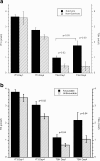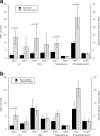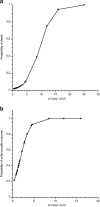Acute neuro-endocrine profile and prediction of outcome after severe brain injury
- PMID: 23601250
- PMCID: PMC3637196
- DOI: 10.1186/1757-7241-21-33
Acute neuro-endocrine profile and prediction of outcome after severe brain injury
Abstract
Object: The aim of the study was to evaluate the early changes in pituitary hormone levels after severe traumatic brain injury (sTBI) and compare hormone levels to basic neuro-intensive care data, a systematic scoring of the CT-findings and to evaluate whether hormone changes are related to outcome.
Methods: Prospective study, including consecutive patients, 15-70 years, with sTBI, Glasgow Coma Scale (GCS) score ≤ 8, initial cerebral perfusion pressure > 10 mm Hg, and arrival to our level one trauma university hospital within 24 hours after head trauma (n = 48). Serum samples were collected in the morning (08-10 am) day 1 and day 4 after sTBI for analysis of cortisol, growth hormone (GH), prolactin, insulin-like growth factor 1 (IGF-1), thyroid-stimulating hormone (TSH), free triiodothyronine (fT3), free thyroxine (fT4), follicular stimulating hormone (FSH), luteinizing hormone (LH), testosterone and sex hormone-binding globulin (SHBG) (men). Serum for cortisol and GH was also obtained in the evening (17-19 pm) at day 1 and day 4. The first CT of the brain was classified according to Marshall. Independent staff evaluated outcome at 3 months using GOS-E.
Results: Profound changes were found for most pituitary-dependent hormones in the acute phase after sTBI, i.e. low levels of thyroid hormones, strong suppression of the pituitary-gonadal axis and increased levels of prolactin. The main findings of this study were: 1) A large proportion (54% day 1 and 70% day 4) of the patients showed morning s-cortisol levels below the proposed cut-off levels for critical illness related corticosteroid insufficiency (CIRCI), i.e. <276 nmol/L (=10 ug/dL), 2) Low s-cortisol was not associated with higher mortality or worse outcome at 3 months, 3) There was a significant association between early (day 1) and strong suppression of the pituitary-gonadal axis and improved survival and favorable functional outcome 3 months after sTBI, 4) Significantly lower levels of fT3 and TSH at day 4 in patients with a poor outcome at 3 months. 5) A higher Marshall CT score was associated with higher day 1 LH/FSH- and lower day 4 TSH levels 6) In general no significant correlation between GCS, ICP or CPP and hormone levels were detected. Only ICPmax and LH day 1 in men was significantly correlated.
Conclusion: Profound dynamic changes in hormone levels are found in the acute phase of sTBI. This is consistent with previous findings in different groups of critically ill patients, most of which are likely to be attributed to physiological adaptation to acute illness. Low cortisol levels were a common finding, and not associated with unfavorable outcome. A retained ability to a dynamic hormonal response, i.e. fast and strong suppression of the pituitary-gonadal axis (day 1) and ability to restore activity in the pituitary-thyroid axis (day 4) was associated with less severe injury according to CT-findings and favorable outcome.
Figures




Similar articles
-
Provocative hypothalamopituitary axis tests in severe head injury: correlations with severity and prognosis.Crit Care Med. 1998 Aug;26(8):1419-26. doi: 10.1097/00003246-199808000-00030. Crit Care Med. 1998. PMID: 9710103
-
[The effect of a single electroconvulsive shock on pituitary-thyroid-adrenal-gonadal axis function in men with severe depression--preliminary report].Psychiatr Pol. 2005 May-Jun;39(3):469-79. Psychiatr Pol. 2005. PMID: 16149757 Polish.
-
Five-day pulsatile gonadotropin-releasing hormone administration unveils combined hypothalamic-pituitary-gonadal defects underlying profound hypoandrogenism in men with prolonged critical illness.J Clin Endocrinol Metab. 2001 Jul;86(7):3217-26. doi: 10.1210/jcem.86.7.7680. J Clin Endocrinol Metab. 2001. PMID: 11443192 Clinical Trial.
-
Endocrinology in intensive care medicine: new insights and therapeutic consequences.Verh K Acad Geneeskd Belg. 2002;64(3):167-87; discussion 187-8. Verh K Acad Geneeskd Belg. 2002. PMID: 12238241 Review.
-
Systemic illness.Pituitary. 2008;11(2):187-207. doi: 10.1007/s11102-008-0112-8. Pituitary. 2008. PMID: 18404385 Review.
Cited by
-
Pituitary dysfunction following mild traumatic brain injury in female athletes.Endocr Connect. 2024 Jan 16;13(2):e230363. doi: 10.1530/EC-23-0363. Print 2024 Feb 1. Endocr Connect. 2024. PMID: 38078923 Free PMC article.
-
Biofluid Biomarkers in Traumatic Brain Injury: A Systematic Scoping Review.Neurocrit Care. 2021 Oct;35(2):559-572. doi: 10.1007/s12028-020-01173-1. Epub 2021 Jan 5. Neurocrit Care. 2021. PMID: 33403583
-
Luteinizing Hormone and Testosterone Levels during Acute Phase of Severe Traumatic Brain Injury: Prognostic Implications for Adult Male Patients.Front Endocrinol (Lausanne). 2018 Feb 13;9:29. doi: 10.3389/fendo.2018.00029. eCollection 2018. Front Endocrinol (Lausanne). 2018. PMID: 29487565 Free PMC article.
-
Association of thyroid hormone concentrations with quality of life of primary brain tumor patients: a pilot study.J Neurooncol. 2017 Jan;131(2):385-391. doi: 10.1007/s11060-016-2311-x. Epub 2016 Nov 9. J Neurooncol. 2017. PMID: 27830477
-
Role and Importance of IGF-1 in Traumatic Brain Injuries.Biomed Res Int. 2015;2015:736104. doi: 10.1155/2015/736104. Epub 2015 Aug 31. Biomed Res Int. 2015. PMID: 26417600 Free PMC article. Review.
References
Publication types
MeSH terms
Substances
LinkOut - more resources
Full Text Sources
Other Literature Sources
Miscellaneous

